SG1015 Financial Accounting: Detailed Financial Ratio Analysis Report
VerifiedAdded on 2023/06/08
|16
|3367
|234
Report
AI Summary
This financial accounting report includes several sections, beginning with an analysis of the financial ratios of Paul and Sons Ltd, followed by a comparative analysis of Brighter Plc and Effi-power Plc, assessing their overall performance. The report also features a cash flow statement for Roselion PLC and a financial statement for Jason. Furthermore, a multi-step profit and loss account for Shiny Future Booksellers Plc is prepared. The report concludes with calculations and discussions on the payback period, rate of return, and net present value (NPV) for a project undertaken by The Happy Family Cereal plc, evaluating its potential impact on the company. This document is available on Desklib, a platform offering a wide range of study tools and solved assignments for students.
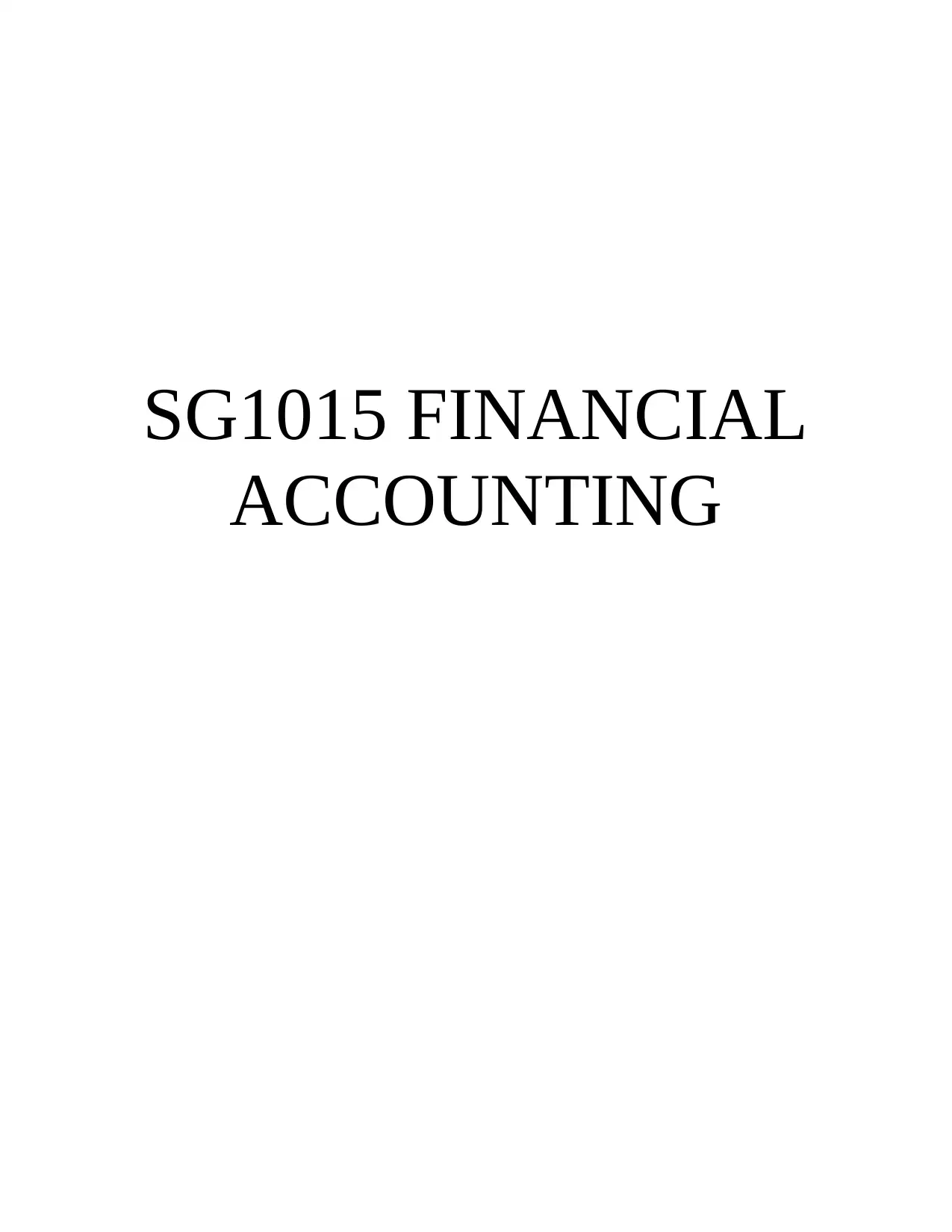
SG1015 FINANCIAL
ACCOUNTING
ACCOUNTING
Paraphrase This Document
Need a fresh take? Get an instant paraphrase of this document with our AI Paraphraser
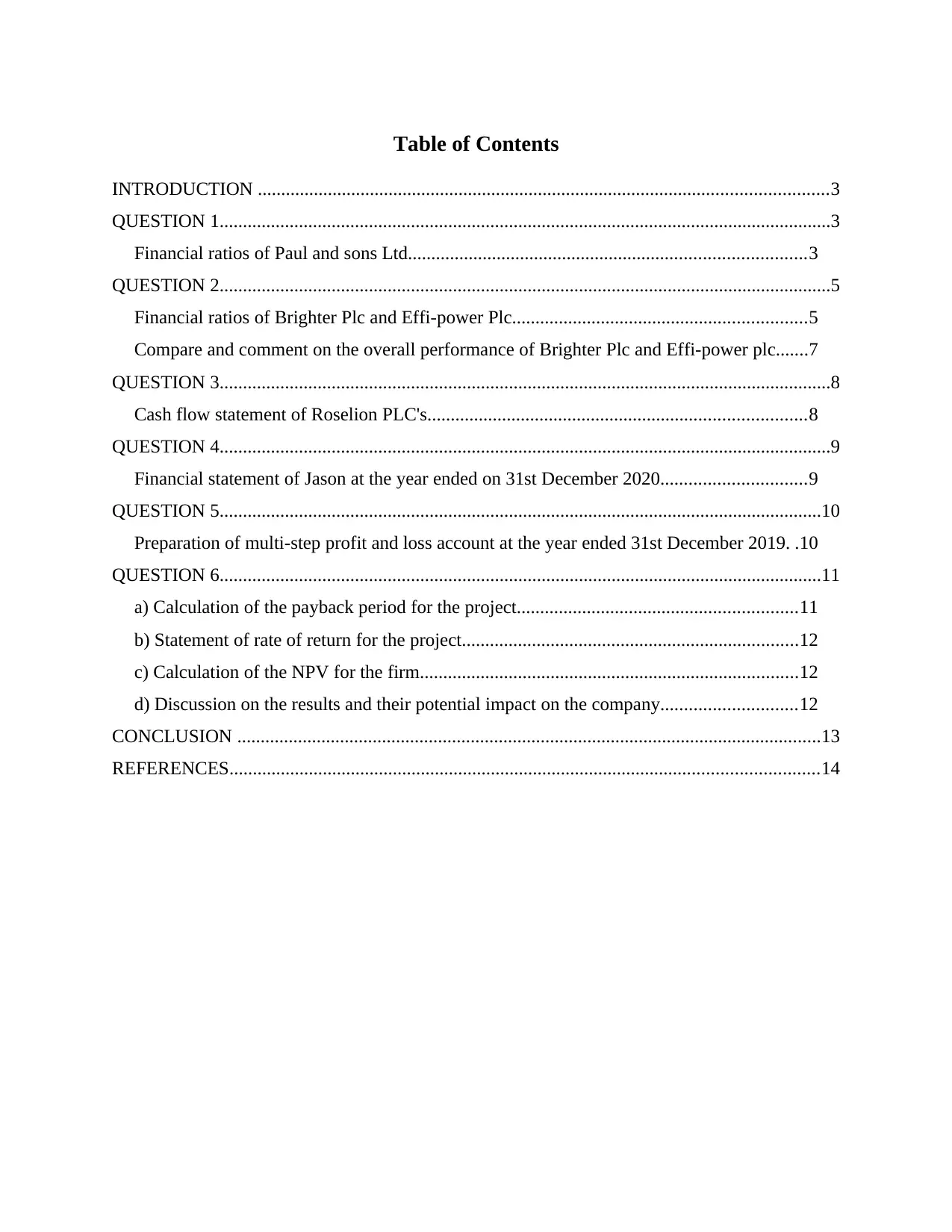
Table of Contents
INTRODUCTION ..........................................................................................................................3
QUESTION 1...................................................................................................................................3
Financial ratios of Paul and sons Ltd.....................................................................................3
QUESTION 2...................................................................................................................................5
Financial ratios of Brighter Plc and Effi-power Plc...............................................................5
Compare and comment on the overall performance of Brighter Plc and Effi-power plc.......7
QUESTION 3...................................................................................................................................8
Cash flow statement of Roselion PLC's.................................................................................8
QUESTION 4...................................................................................................................................9
Financial statement of Jason at the year ended on 31st December 2020...............................9
QUESTION 5.................................................................................................................................10
Preparation of multi-step profit and loss account at the year ended 31st December 2019. .10
QUESTION 6.................................................................................................................................11
a) Calculation of the payback period for the project............................................................11
b) Statement of rate of return for the project........................................................................12
c) Calculation of the NPV for the firm.................................................................................12
d) Discussion on the results and their potential impact on the company.............................12
CONCLUSION .............................................................................................................................13
REFERENCES..............................................................................................................................14
INTRODUCTION ..........................................................................................................................3
QUESTION 1...................................................................................................................................3
Financial ratios of Paul and sons Ltd.....................................................................................3
QUESTION 2...................................................................................................................................5
Financial ratios of Brighter Plc and Effi-power Plc...............................................................5
Compare and comment on the overall performance of Brighter Plc and Effi-power plc.......7
QUESTION 3...................................................................................................................................8
Cash flow statement of Roselion PLC's.................................................................................8
QUESTION 4...................................................................................................................................9
Financial statement of Jason at the year ended on 31st December 2020...............................9
QUESTION 5.................................................................................................................................10
Preparation of multi-step profit and loss account at the year ended 31st December 2019. .10
QUESTION 6.................................................................................................................................11
a) Calculation of the payback period for the project............................................................11
b) Statement of rate of return for the project........................................................................12
c) Calculation of the NPV for the firm.................................................................................12
d) Discussion on the results and their potential impact on the company.............................12
CONCLUSION .............................................................................................................................13
REFERENCES..............................................................................................................................14

INTRODUCTION
Financial accounting is a backbone of accounting. It includes recording, summarizing and
reporting of business transaction in a specific time period. These transaction helps to preparation
of annual records of the company such as assets and liabilities statement, income statements and
fund flow statement. Bookkeeping can be found in public and private sector. The duties of
financial accounting is different from accountant because it works for the company purpose. The
financial accounting contains various accounting principles that helps to determining the
financial position of the company. It follows the concept of cash and accrual accounting. It
focuses on the five areas such as revenues, expenses, assets, liabilities and equity (Arnold, 2018).
In this report to calculate the financial ratios of Paul and sons ltd, Brighter Plc and Eff-power Plc
and compare the performance of these two businesses. Further in this report preparation of cash
flow statement of Roselion Plc and determine the financial position of Jason. To calculate the
payback period, ARR and NPV of The Happy Family Cereal plc.
QUESTION 1
Financial ratios of Paul and sons Ltd
Ratio analysis is based on the accounting figure that does not provides the accurate
accounting information. It does not compares the figure of balance sheet, profit and loss
accounting and other accounting data, it compares the figure of previous year. Different
accounting ratios define the overall performance of the company (Bensaadi and Asyiah, 2022).
Profitability ratios- These ratio measures the operational efficiency of the business. These
includes:
1. Gross profit Ratio- It defines the relationship between gross profit and sales.
Particulars 2020(£000) 2021(£000)
Gross profit*100/sales revenue 3450*100/4600 = 75% 2590*100/4840= 53.51%
Comment- Gross profit should be always positive number. In year 2021 shows less gross profit
as compare to 2020. Company should focuses on the sale and increases the profit of the
company.
Financial accounting is a backbone of accounting. It includes recording, summarizing and
reporting of business transaction in a specific time period. These transaction helps to preparation
of annual records of the company such as assets and liabilities statement, income statements and
fund flow statement. Bookkeeping can be found in public and private sector. The duties of
financial accounting is different from accountant because it works for the company purpose. The
financial accounting contains various accounting principles that helps to determining the
financial position of the company. It follows the concept of cash and accrual accounting. It
focuses on the five areas such as revenues, expenses, assets, liabilities and equity (Arnold, 2018).
In this report to calculate the financial ratios of Paul and sons ltd, Brighter Plc and Eff-power Plc
and compare the performance of these two businesses. Further in this report preparation of cash
flow statement of Roselion Plc and determine the financial position of Jason. To calculate the
payback period, ARR and NPV of The Happy Family Cereal plc.
QUESTION 1
Financial ratios of Paul and sons Ltd
Ratio analysis is based on the accounting figure that does not provides the accurate
accounting information. It does not compares the figure of balance sheet, profit and loss
accounting and other accounting data, it compares the figure of previous year. Different
accounting ratios define the overall performance of the company (Bensaadi and Asyiah, 2022).
Profitability ratios- These ratio measures the operational efficiency of the business. These
includes:
1. Gross profit Ratio- It defines the relationship between gross profit and sales.
Particulars 2020(£000) 2021(£000)
Gross profit*100/sales revenue 3450*100/4600 = 75% 2590*100/4840= 53.51%
Comment- Gross profit should be always positive number. In year 2021 shows less gross profit
as compare to 2020. Company should focuses on the sale and increases the profit of the
company.
⊘ This is a preview!⊘
Do you want full access?
Subscribe today to unlock all pages.

Trusted by 1+ million students worldwide
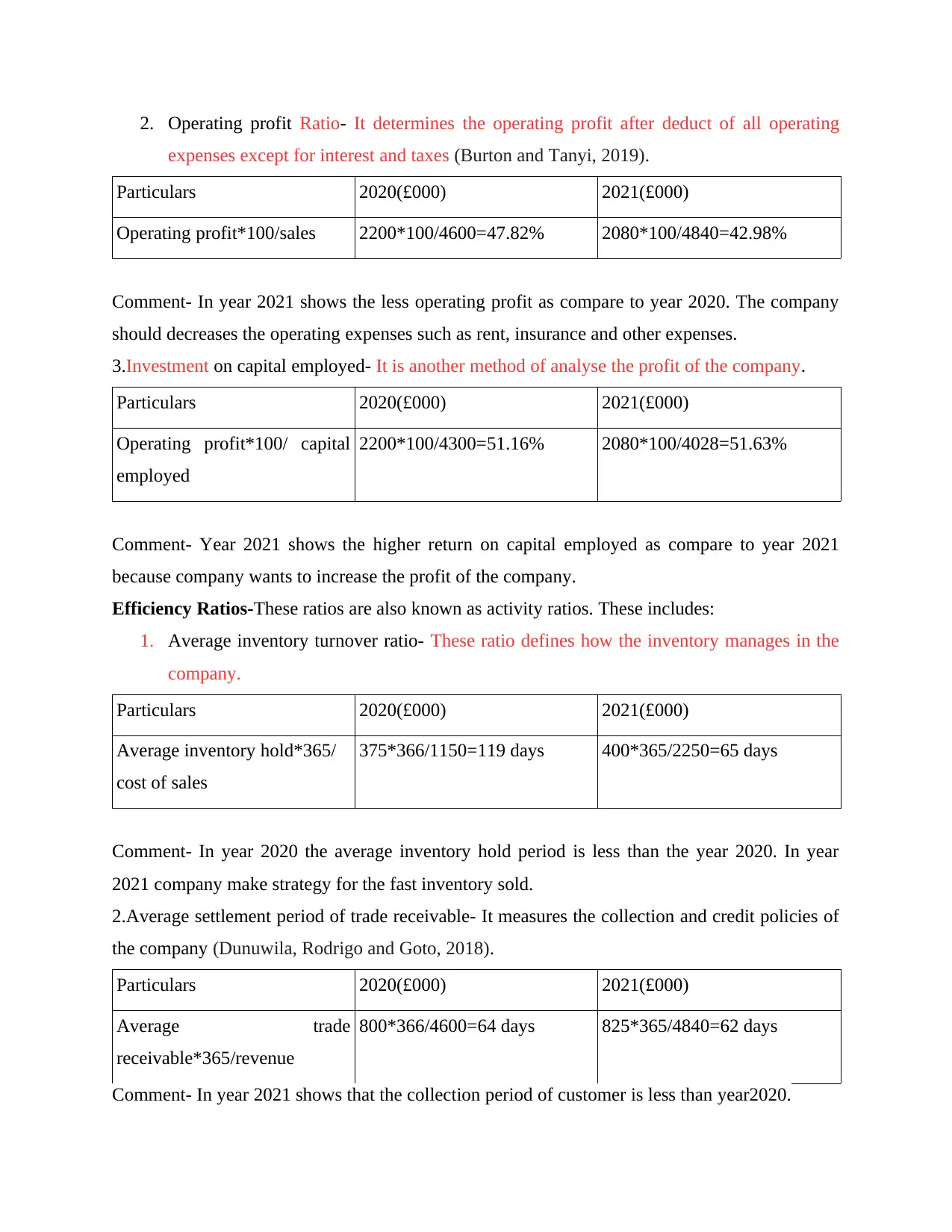
2. Operating profit Ratio- It determines the operating profit after deduct of all operating
expenses except for interest and taxes (Burton and Tanyi, 2019).
Particulars 2020(£000) 2021(£000)
Operating profit*100/sales 2200*100/4600=47.82% 2080*100/4840=42.98%
Comment- In year 2021 shows the less operating profit as compare to year 2020. The company
should decreases the operating expenses such as rent, insurance and other expenses.
3.Investment on capital employed- It is another method of analyse the profit of the company.
Particulars 2020(£000) 2021(£000)
Operating profit*100/ capital
employed
2200*100/4300=51.16% 2080*100/4028=51.63%
Comment- Year 2021 shows the higher return on capital employed as compare to year 2021
because company wants to increase the profit of the company.
Efficiency Ratios-These ratios are also known as activity ratios. These includes:
1. Average inventory turnover ratio- These ratio defines how the inventory manages in the
company.
Particulars 2020(£000) 2021(£000)
Average inventory hold*365/
cost of sales
375*366/1150=119 days 400*365/2250=65 days
Comment- In year 2020 the average inventory hold period is less than the year 2020. In year
2021 company make strategy for the fast inventory sold.
2.Average settlement period of trade receivable- It measures the collection and credit policies of
the company (Dunuwila, Rodrigo and Goto, 2018).
Particulars 2020(£000) 2021(£000)
Average trade
receivable*365/revenue
800*366/4600=64 days 825*365/4840=62 days
Comment- In year 2021 shows that the collection period of customer is less than year2020.
expenses except for interest and taxes (Burton and Tanyi, 2019).
Particulars 2020(£000) 2021(£000)
Operating profit*100/sales 2200*100/4600=47.82% 2080*100/4840=42.98%
Comment- In year 2021 shows the less operating profit as compare to year 2020. The company
should decreases the operating expenses such as rent, insurance and other expenses.
3.Investment on capital employed- It is another method of analyse the profit of the company.
Particulars 2020(£000) 2021(£000)
Operating profit*100/ capital
employed
2200*100/4300=51.16% 2080*100/4028=51.63%
Comment- Year 2021 shows the higher return on capital employed as compare to year 2021
because company wants to increase the profit of the company.
Efficiency Ratios-These ratios are also known as activity ratios. These includes:
1. Average inventory turnover ratio- These ratio defines how the inventory manages in the
company.
Particulars 2020(£000) 2021(£000)
Average inventory hold*365/
cost of sales
375*366/1150=119 days 400*365/2250=65 days
Comment- In year 2020 the average inventory hold period is less than the year 2020. In year
2021 company make strategy for the fast inventory sold.
2.Average settlement period of trade receivable- It measures the collection and credit policies of
the company (Dunuwila, Rodrigo and Goto, 2018).
Particulars 2020(£000) 2021(£000)
Average trade
receivable*365/revenue
800*366/4600=64 days 825*365/4840=62 days
Comment- In year 2021 shows that the collection period of customer is less than year2020.
Paraphrase This Document
Need a fresh take? Get an instant paraphrase of this document with our AI Paraphraser
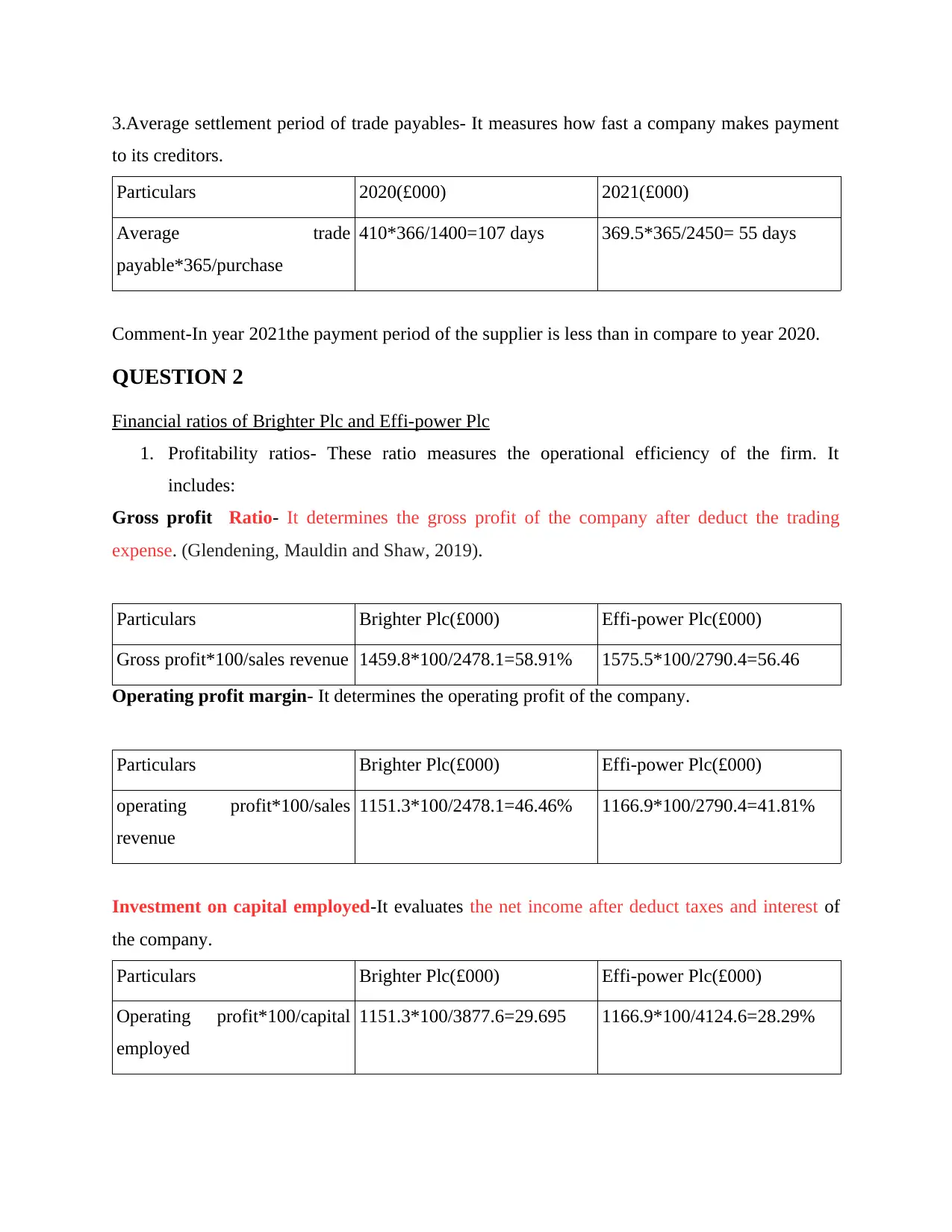
3.Average settlement period of trade payables- It measures how fast a company makes payment
to its creditors.
Particulars 2020(£000) 2021(£000)
Average trade
payable*365/purchase
410*366/1400=107 days 369.5*365/2450= 55 days
Comment-In year 2021the payment period of the supplier is less than in compare to year 2020.
QUESTION 2
Financial ratios of Brighter Plc and Effi-power Plc
1. Profitability ratios- These ratio measures the operational efficiency of the firm. It
includes:
Gross profit Ratio- It determines the gross profit of the company after deduct the trading
expense. (Glendening, Mauldin and Shaw, 2019).
Particulars Brighter Plc(£000) Effi-power Plc(£000)
Gross profit*100/sales revenue 1459.8*100/2478.1=58.91% 1575.5*100/2790.4=56.46
Operating profit margin- It determines the operating profit of the company.
Particulars Brighter Plc(£000) Effi-power Plc(£000)
operating profit*100/sales
revenue
1151.3*100/2478.1=46.46% 1166.9*100/2790.4=41.81%
Investment on capital employed-It evaluates the net income after deduct taxes and interest of
the company.
Particulars Brighter Plc(£000) Effi-power Plc(£000)
Operating profit*100/capital
employed
1151.3*100/3877.6=29.695 1166.9*100/4124.6=28.29%
to its creditors.
Particulars 2020(£000) 2021(£000)
Average trade
payable*365/purchase
410*366/1400=107 days 369.5*365/2450= 55 days
Comment-In year 2021the payment period of the supplier is less than in compare to year 2020.
QUESTION 2
Financial ratios of Brighter Plc and Effi-power Plc
1. Profitability ratios- These ratio measures the operational efficiency of the firm. It
includes:
Gross profit Ratio- It determines the gross profit of the company after deduct the trading
expense. (Glendening, Mauldin and Shaw, 2019).
Particulars Brighter Plc(£000) Effi-power Plc(£000)
Gross profit*100/sales revenue 1459.8*100/2478.1=58.91% 1575.5*100/2790.4=56.46
Operating profit margin- It determines the operating profit of the company.
Particulars Brighter Plc(£000) Effi-power Plc(£000)
operating profit*100/sales
revenue
1151.3*100/2478.1=46.46% 1166.9*100/2790.4=41.81%
Investment on capital employed-It evaluates the net income after deduct taxes and interest of
the company.
Particulars Brighter Plc(£000) Effi-power Plc(£000)
Operating profit*100/capital
employed
1151.3*100/3877.6=29.695 1166.9*100/4124.6=28.29%
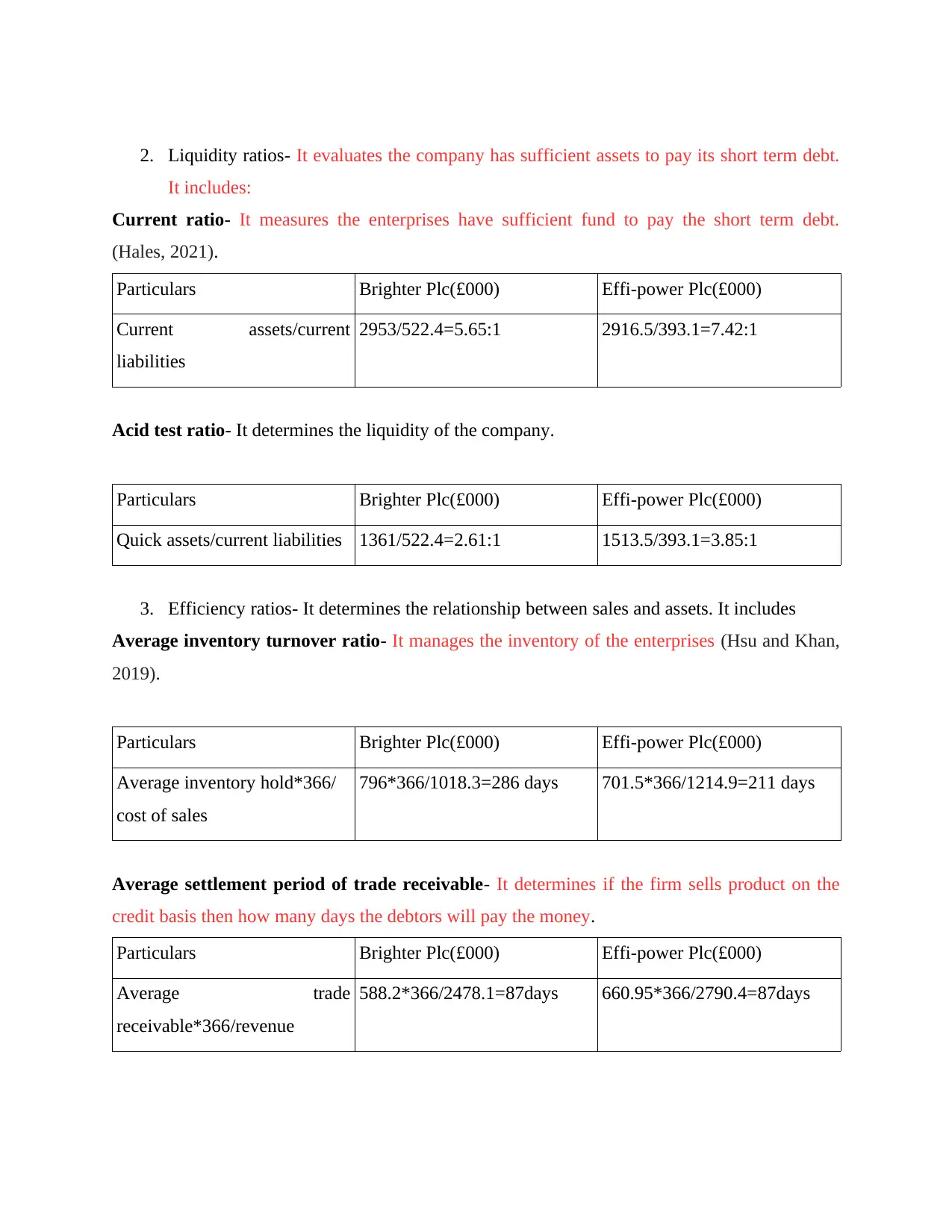
2. Liquidity ratios- It evaluates the company has sufficient assets to pay its short term debt.
It includes:
Current ratio- It measures the enterprises have sufficient fund to pay the short term debt.
(Hales, 2021).
Particulars Brighter Plc(£000) Effi-power Plc(£000)
Current assets/current
liabilities
2953/522.4=5.65:1 2916.5/393.1=7.42:1
Acid test ratio- It determines the liquidity of the company.
Particulars Brighter Plc(£000) Effi-power Plc(£000)
Quick assets/current liabilities 1361/522.4=2.61:1 1513.5/393.1=3.85:1
3. Efficiency ratios- It determines the relationship between sales and assets. It includes
Average inventory turnover ratio- It manages the inventory of the enterprises (Hsu and Khan,
2019).
Particulars Brighter Plc(£000) Effi-power Plc(£000)
Average inventory hold*366/
cost of sales
796*366/1018.3=286 days 701.5*366/1214.9=211 days
Average settlement period of trade receivable- It determines if the firm sells product on the
credit basis then how many days the debtors will pay the money.
Particulars Brighter Plc(£000) Effi-power Plc(£000)
Average trade
receivable*366/revenue
588.2*366/2478.1=87days 660.95*366/2790.4=87days
It includes:
Current ratio- It measures the enterprises have sufficient fund to pay the short term debt.
(Hales, 2021).
Particulars Brighter Plc(£000) Effi-power Plc(£000)
Current assets/current
liabilities
2953/522.4=5.65:1 2916.5/393.1=7.42:1
Acid test ratio- It determines the liquidity of the company.
Particulars Brighter Plc(£000) Effi-power Plc(£000)
Quick assets/current liabilities 1361/522.4=2.61:1 1513.5/393.1=3.85:1
3. Efficiency ratios- It determines the relationship between sales and assets. It includes
Average inventory turnover ratio- It manages the inventory of the enterprises (Hsu and Khan,
2019).
Particulars Brighter Plc(£000) Effi-power Plc(£000)
Average inventory hold*366/
cost of sales
796*366/1018.3=286 days 701.5*366/1214.9=211 days
Average settlement period of trade receivable- It determines if the firm sells product on the
credit basis then how many days the debtors will pay the money.
Particulars Brighter Plc(£000) Effi-power Plc(£000)
Average trade
receivable*366/revenue
588.2*366/2478.1=87days 660.95*366/2790.4=87days
⊘ This is a preview!⊘
Do you want full access?
Subscribe today to unlock all pages.

Trusted by 1+ million students worldwide
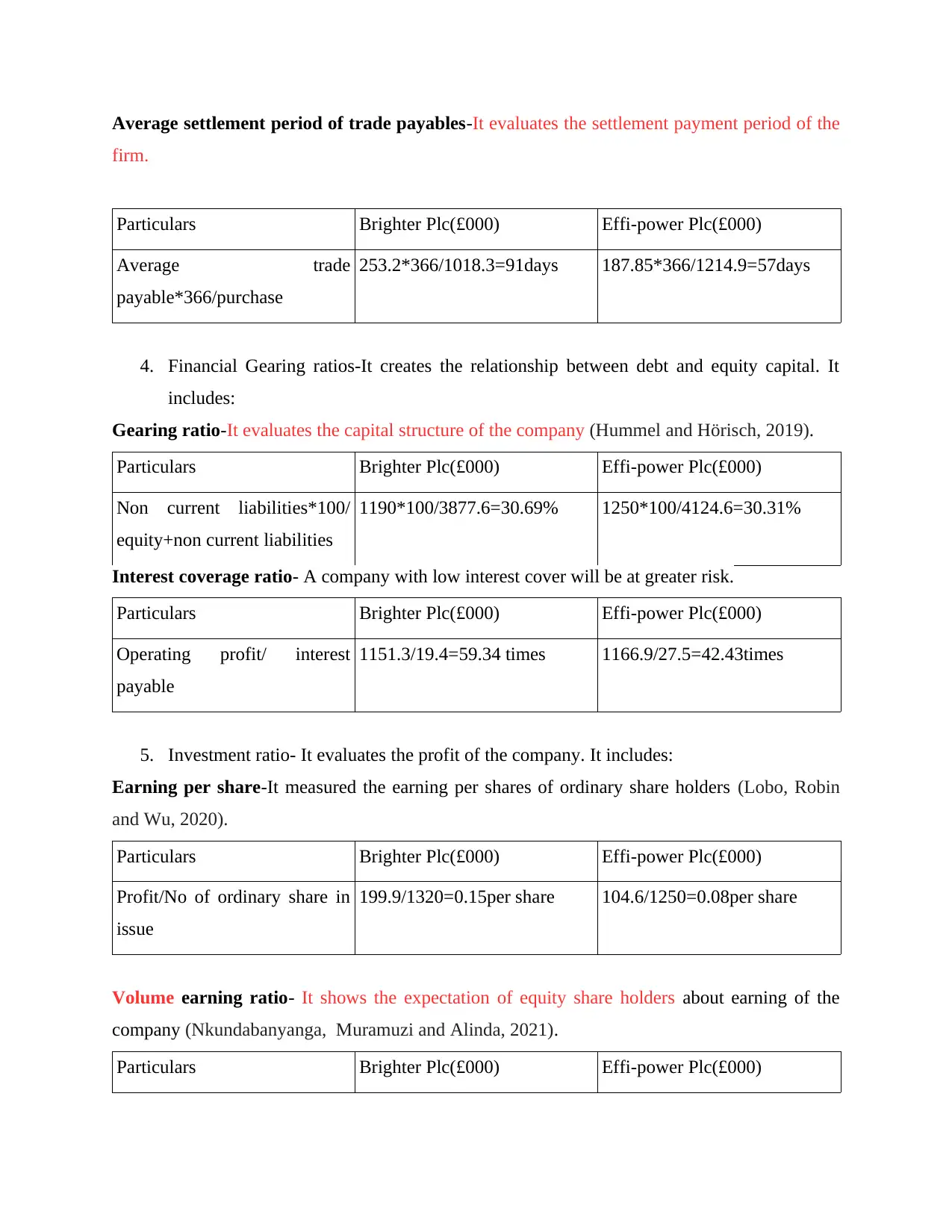
Average settlement period of trade payables-It evaluates the settlement payment period of the
firm.
Particulars Brighter Plc(£000) Effi-power Plc(£000)
Average trade
payable*366/purchase
253.2*366/1018.3=91days 187.85*366/1214.9=57days
4. Financial Gearing ratios-It creates the relationship between debt and equity capital. It
includes:
Gearing ratio-It evaluates the capital structure of the company (Hummel and Hörisch, 2019).
Particulars Brighter Plc(£000) Effi-power Plc(£000)
Non current liabilities*100/
equity+non current liabilities
1190*100/3877.6=30.69% 1250*100/4124.6=30.31%
Interest coverage ratio- A company with low interest cover will be at greater risk.
Particulars Brighter Plc(£000) Effi-power Plc(£000)
Operating profit/ interest
payable
1151.3/19.4=59.34 times 1166.9/27.5=42.43times
5. Investment ratio- It evaluates the profit of the company. It includes:
Earning per share-It measured the earning per shares of ordinary share holders (Lobo, Robin
and Wu, 2020).
Particulars Brighter Plc(£000) Effi-power Plc(£000)
Profit/No of ordinary share in
issue
199.9/1320=0.15per share 104.6/1250=0.08per share
Volume earning ratio- It shows the expectation of equity share holders about earning of the
company (Nkundabanyanga, Muramuzi and Alinda, 2021).
Particulars Brighter Plc(£000) Effi-power Plc(£000)
firm.
Particulars Brighter Plc(£000) Effi-power Plc(£000)
Average trade
payable*366/purchase
253.2*366/1018.3=91days 187.85*366/1214.9=57days
4. Financial Gearing ratios-It creates the relationship between debt and equity capital. It
includes:
Gearing ratio-It evaluates the capital structure of the company (Hummel and Hörisch, 2019).
Particulars Brighter Plc(£000) Effi-power Plc(£000)
Non current liabilities*100/
equity+non current liabilities
1190*100/3877.6=30.69% 1250*100/4124.6=30.31%
Interest coverage ratio- A company with low interest cover will be at greater risk.
Particulars Brighter Plc(£000) Effi-power Plc(£000)
Operating profit/ interest
payable
1151.3/19.4=59.34 times 1166.9/27.5=42.43times
5. Investment ratio- It evaluates the profit of the company. It includes:
Earning per share-It measured the earning per shares of ordinary share holders (Lobo, Robin
and Wu, 2020).
Particulars Brighter Plc(£000) Effi-power Plc(£000)
Profit/No of ordinary share in
issue
199.9/1320=0.15per share 104.6/1250=0.08per share
Volume earning ratio- It shows the expectation of equity share holders about earning of the
company (Nkundabanyanga, Muramuzi and Alinda, 2021).
Particulars Brighter Plc(£000) Effi-power Plc(£000)
Paraphrase This Document
Need a fresh take? Get an instant paraphrase of this document with our AI Paraphraser

Market value per share/
earning per share
6.50/0.15=43.33times 8.20/0.08=102.5 times
Compare and comment on the overall performance of Brighter Plc and Effi-power plc
The different financial ratio shows that the brighter plc and Effi-power plc both are profit
generating company and both company can survive in the dynamic environment for the long
period. The Brighter Plc shows more profit as compare to Effi-power plc. The Brighter plc
shows more trading profit, recurring profit and investment on capital structure as compare to
Effi-power plc. It is favourable sign of good management. The generally accepted current ratio is
2:1. Both of the company have sufficient found to pay its liabilities. The Effi-power plc has more
financial funds to pay its liabilities as compare to Brighter plc. Both of the companies shows the
trade credit period to consumers, while positive ratio determines that the settlement against
customers rapidly. The Effi-power plc stock holding period is less than as compare to brighter
plc it means the Effi-power utilizes its inventory fast. The payment period of creditor less than as
compare to brighter plc it means the liberal credit terms granted by suppliers are settled rapidly.
Both of the company earn higher profit and interest has paid out of the profit. The profitability of
the both of company can be measured in terms of EPS. Both the company generate higher profit
and distributed the profit to its equity shareholder. The financial ratios conclude that both
company can survive till future without suffering any losses.
QUESTION 3
Cash flow statement of Roselion PLC's
Cash flow statement - Statistics approximately the cash flows of an business enterprise is
beneficial in providing users of economic statements with a foundation to assess the ability of the
organization to generate cash and coins equivalents and the needs of the organization to utilise
the ones coins flows. The economic selection that are taken buy customers require an evaluation
of the potential of an organisations to generate cash and cash equivalents and the timing and
actuality in their generation. It affords information about the adjustments in cash and cash
equivalents of an corporation(Pavone and Migliaccio, 2021).
Roselion PLC's
Cash flow statement
For the period of 31st December 2019
earning per share
6.50/0.15=43.33times 8.20/0.08=102.5 times
Compare and comment on the overall performance of Brighter Plc and Effi-power plc
The different financial ratio shows that the brighter plc and Effi-power plc both are profit
generating company and both company can survive in the dynamic environment for the long
period. The Brighter Plc shows more profit as compare to Effi-power plc. The Brighter plc
shows more trading profit, recurring profit and investment on capital structure as compare to
Effi-power plc. It is favourable sign of good management. The generally accepted current ratio is
2:1. Both of the company have sufficient found to pay its liabilities. The Effi-power plc has more
financial funds to pay its liabilities as compare to Brighter plc. Both of the companies shows the
trade credit period to consumers, while positive ratio determines that the settlement against
customers rapidly. The Effi-power plc stock holding period is less than as compare to brighter
plc it means the Effi-power utilizes its inventory fast. The payment period of creditor less than as
compare to brighter plc it means the liberal credit terms granted by suppliers are settled rapidly.
Both of the company earn higher profit and interest has paid out of the profit. The profitability of
the both of company can be measured in terms of EPS. Both the company generate higher profit
and distributed the profit to its equity shareholder. The financial ratios conclude that both
company can survive till future without suffering any losses.
QUESTION 3
Cash flow statement of Roselion PLC's
Cash flow statement - Statistics approximately the cash flows of an business enterprise is
beneficial in providing users of economic statements with a foundation to assess the ability of the
organization to generate cash and coins equivalents and the needs of the organization to utilise
the ones coins flows. The economic selection that are taken buy customers require an evaluation
of the potential of an organisations to generate cash and cash equivalents and the timing and
actuality in their generation. It affords information about the adjustments in cash and cash
equivalents of an corporation(Pavone and Migliaccio, 2021).
Roselion PLC's
Cash flow statement
For the period of 31st December 2019
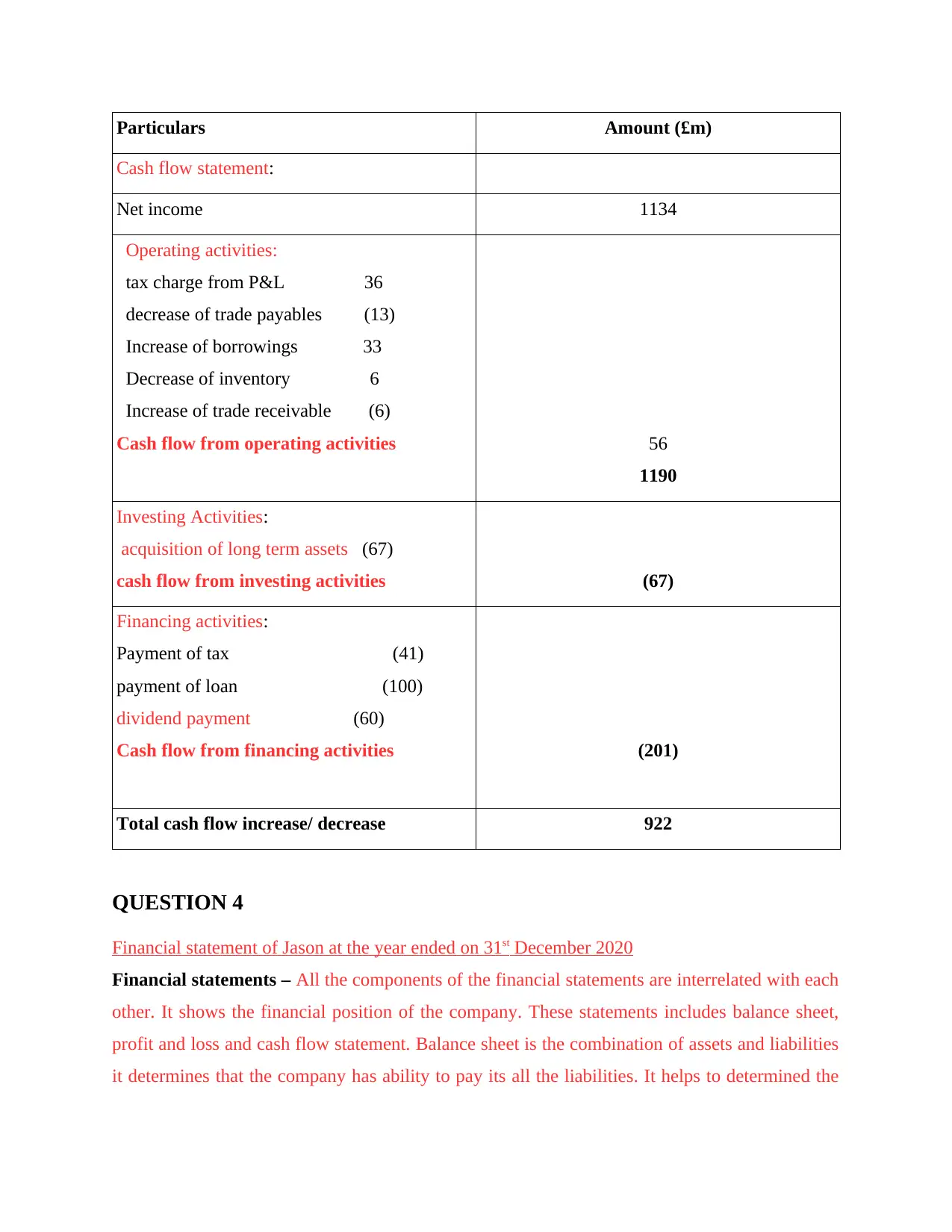
Particulars Amount (£m)
Cash flow statement:
Net income 1134
Operating activities:
tax charge from P&L 36
decrease of trade payables (13)
Increase of borrowings 33
Decrease of inventory 6
Increase of trade receivable (6)
Cash flow from operating activities 56
1190
Investing Activities:
acquisition of long term assets (67)
cash flow from investing activities (67)
Financing activities:
Payment of tax (41)
payment of loan (100)
dividend payment (60)
Cash flow from financing activities (201)
Total cash flow increase/ decrease 922
QUESTION 4
Financial statement of Jason at the year ended on 31st December 2020
Financial statements – All the components of the financial statements are interrelated with each
other. It shows the financial position of the company. These statements includes balance sheet,
profit and loss and cash flow statement. Balance sheet is the combination of assets and liabilities
it determines that the company has ability to pay its all the liabilities. It helps to determined the
Cash flow statement:
Net income 1134
Operating activities:
tax charge from P&L 36
decrease of trade payables (13)
Increase of borrowings 33
Decrease of inventory 6
Increase of trade receivable (6)
Cash flow from operating activities 56
1190
Investing Activities:
acquisition of long term assets (67)
cash flow from investing activities (67)
Financing activities:
Payment of tax (41)
payment of loan (100)
dividend payment (60)
Cash flow from financing activities (201)
Total cash flow increase/ decrease 922
QUESTION 4
Financial statement of Jason at the year ended on 31st December 2020
Financial statements – All the components of the financial statements are interrelated with each
other. It shows the financial position of the company. These statements includes balance sheet,
profit and loss and cash flow statement. Balance sheet is the combination of assets and liabilities
it determines that the company has ability to pay its all the liabilities. It helps to determined the
⊘ This is a preview!⊘
Do you want full access?
Subscribe today to unlock all pages.

Trusted by 1+ million students worldwide
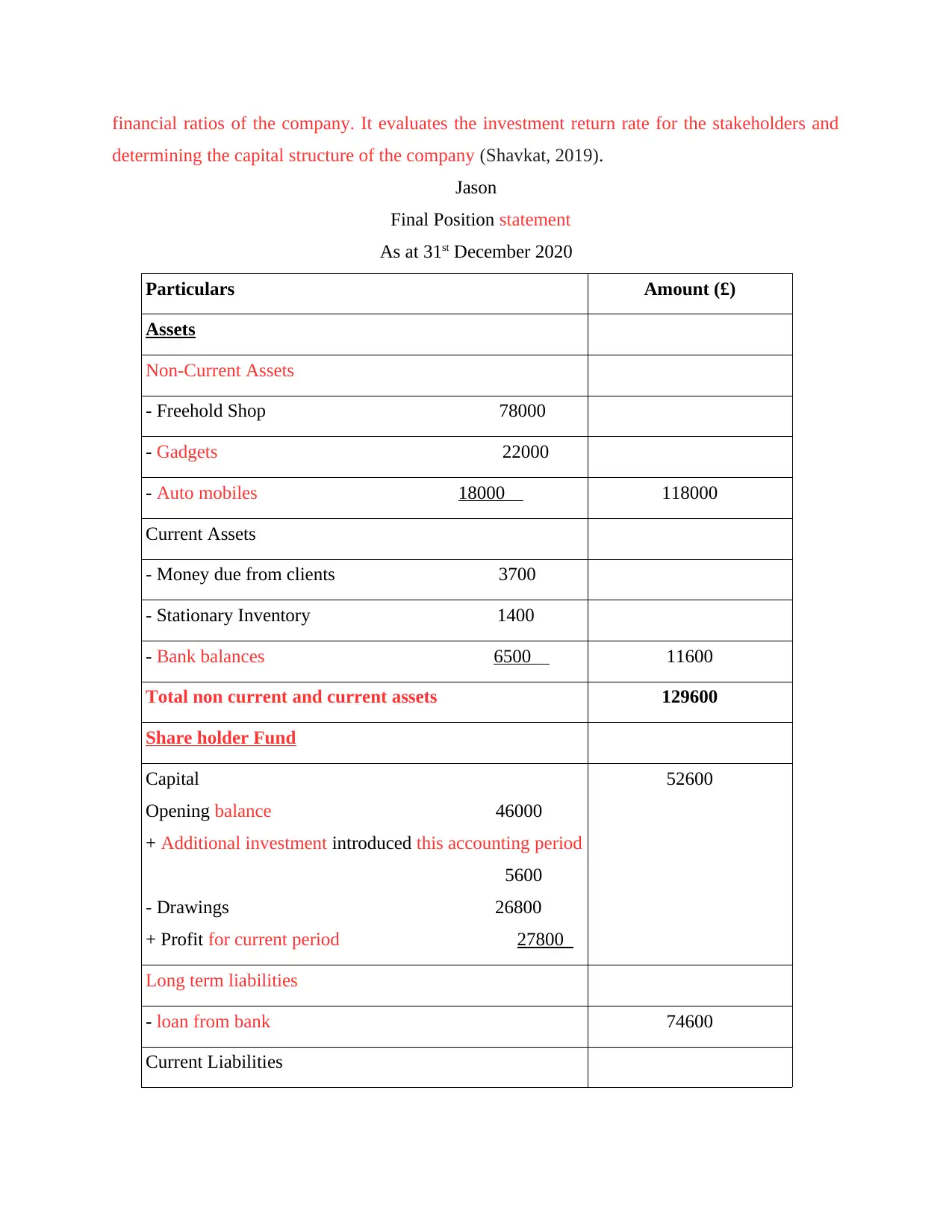
financial ratios of the company. It evaluates the investment return rate for the stakeholders and
determining the capital structure of the company (Shavkat, 2019).
Jason
Final Position statement
As at 31st December 2020
Particulars Amount (£)
Assets
Non-Current Assets
- Freehold Shop 78000
- Gadgets 22000
- Auto mobiles 18000 118000
Current Assets
- Money due from clients 3700
- Stationary Inventory 1400
- Bank balances 6500 11600
Total non current and current assets 129600
Share holder Fund
Capital
Opening balance 46000
+ Additional investment introduced this accounting period
5600
- Drawings 26800
+ Profit for current period 27800
52600
Long term liabilities
- loan from bank 74600
Current Liabilities
determining the capital structure of the company (Shavkat, 2019).
Jason
Final Position statement
As at 31st December 2020
Particulars Amount (£)
Assets
Non-Current Assets
- Freehold Shop 78000
- Gadgets 22000
- Auto mobiles 18000 118000
Current Assets
- Money due from clients 3700
- Stationary Inventory 1400
- Bank balances 6500 11600
Total non current and current assets 129600
Share holder Fund
Capital
Opening balance 46000
+ Additional investment introduced this accounting period
5600
- Drawings 26800
+ Profit for current period 27800
52600
Long term liabilities
- loan from bank 74600
Current Liabilities
Paraphrase This Document
Need a fresh take? Get an instant paraphrase of this document with our AI Paraphraser
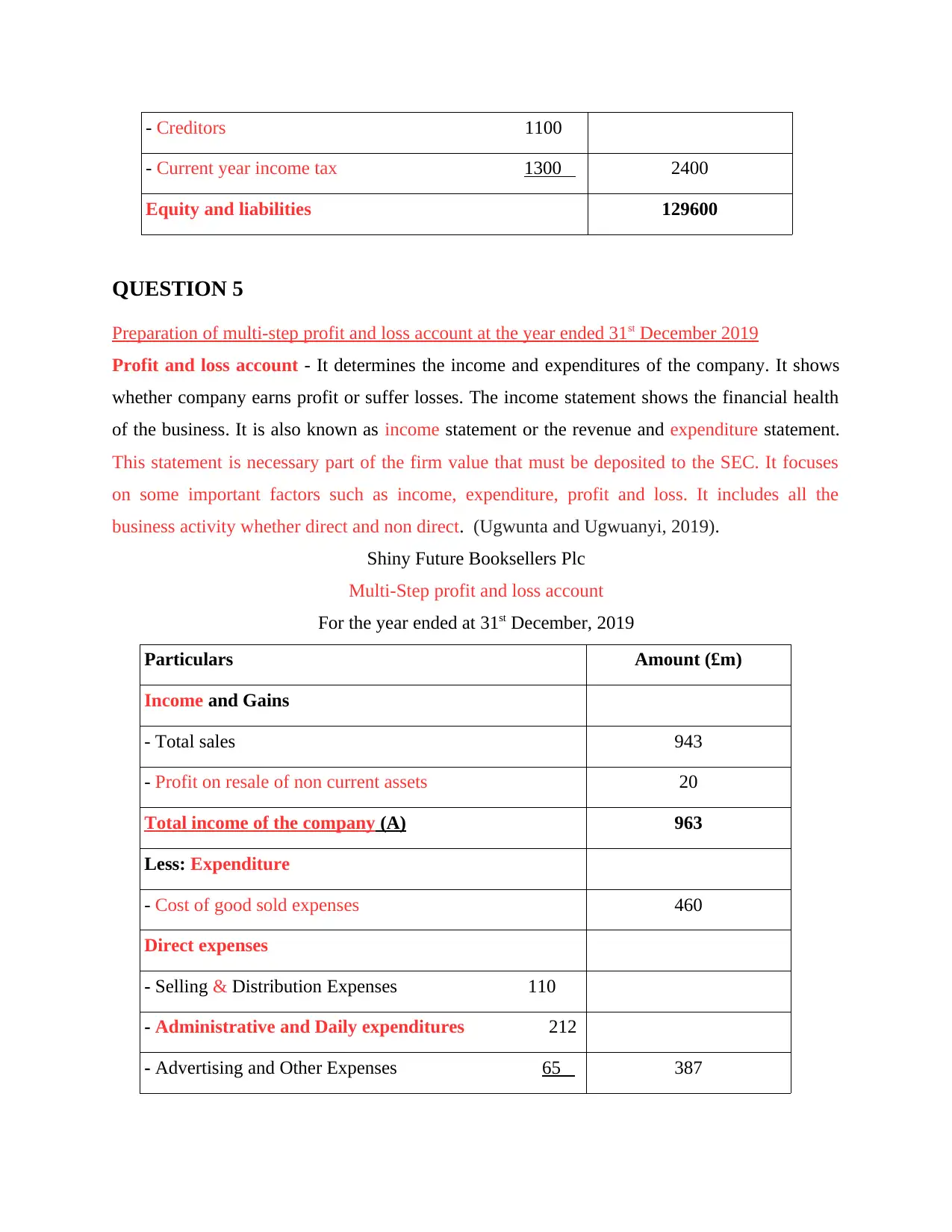
- Creditors 1100
- Current year income tax 1300 2400
Equity and liabilities 129600
QUESTION 5
Preparation of multi-step profit and loss account at the year ended 31st December 2019
Profit and loss account - It determines the income and expenditures of the company. It shows
whether company earns profit or suffer losses. The income statement shows the financial health
of the business. It is also known as income statement or the revenue and expenditure statement.
This statement is necessary part of the firm value that must be deposited to the SEC. It focuses
on some important factors such as income, expenditure, profit and loss. It includes all the
business activity whether direct and non direct. (Ugwunta and Ugwuanyi, 2019).
Shiny Future Booksellers Plc
Multi-Step profit and loss account
For the year ended at 31st December, 2019
Particulars Amount (£m)
Income and Gains
- Total sales 943
- Profit on resale of non current assets 20
Total income of the company (A) 963
Less: Expenditure
- Cost of good sold expenses 460
Direct expenses
- Selling & Distribution Expenses 110
- Administrative and Daily expenditures 212
- Advertising and Other Expenses 65 387
- Current year income tax 1300 2400
Equity and liabilities 129600
QUESTION 5
Preparation of multi-step profit and loss account at the year ended 31st December 2019
Profit and loss account - It determines the income and expenditures of the company. It shows
whether company earns profit or suffer losses. The income statement shows the financial health
of the business. It is also known as income statement or the revenue and expenditure statement.
This statement is necessary part of the firm value that must be deposited to the SEC. It focuses
on some important factors such as income, expenditure, profit and loss. It includes all the
business activity whether direct and non direct. (Ugwunta and Ugwuanyi, 2019).
Shiny Future Booksellers Plc
Multi-Step profit and loss account
For the year ended at 31st December, 2019
Particulars Amount (£m)
Income and Gains
- Total sales 943
- Profit on resale of non current assets 20
Total income of the company (A) 963
Less: Expenditure
- Cost of good sold expenses 460
Direct expenses
- Selling & Distribution Expenses 110
- Administrative and Daily expenditures 212
- Advertising and Other Expenses 65 387
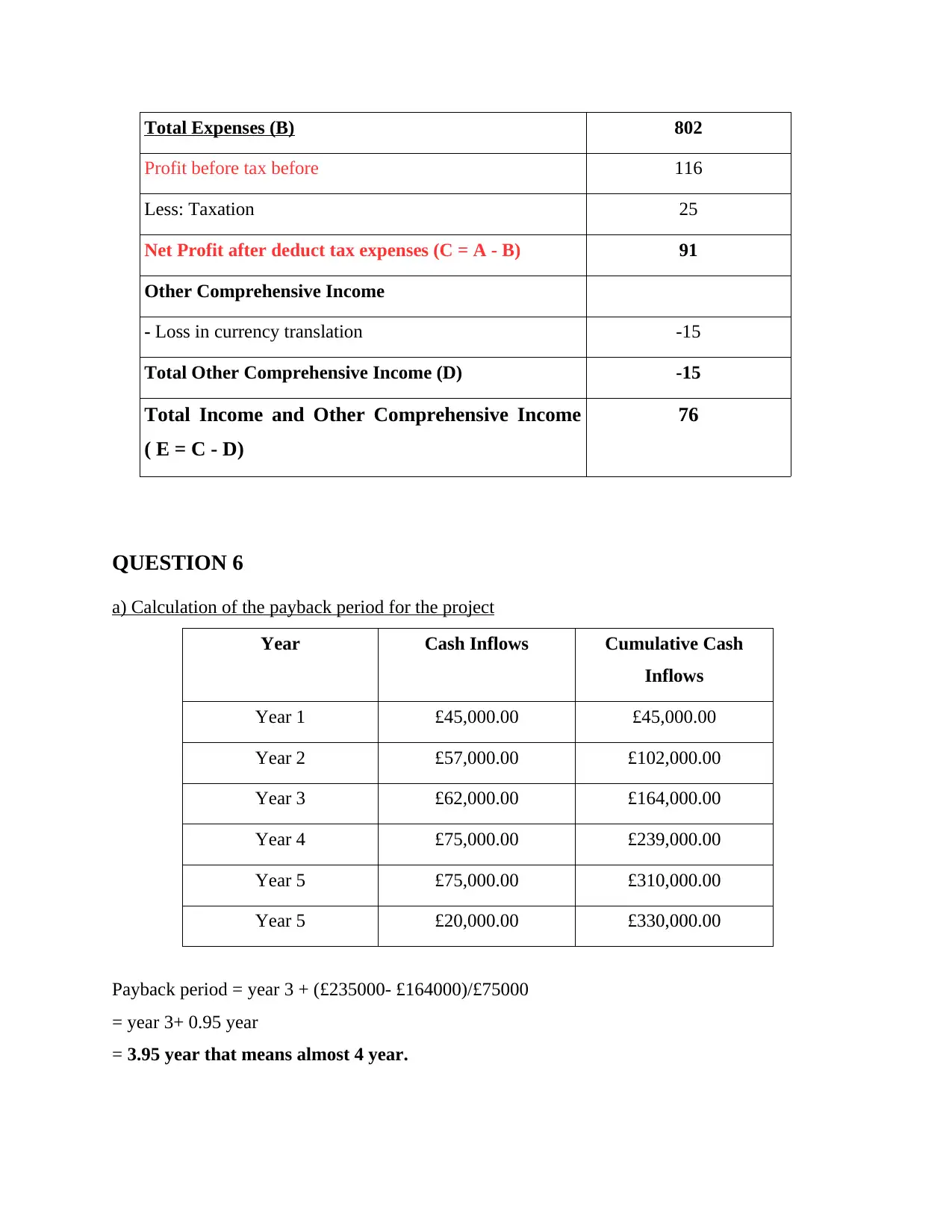
Total Expenses (B) 802
Profit before tax before 116
Less: Taxation 25
Net Profit after deduct tax expenses (C = A - B) 91
Other Comprehensive Income
- Loss in currency translation -15
Total Other Comprehensive Income (D) -15
Total Income and Other Comprehensive Income
( E = C - D)
76
QUESTION 6
a) Calculation of the payback period for the project
Year Cash Inflows Cumulative Cash
Inflows
Year 1 £45,000.00 £45,000.00
Year 2 £57,000.00 £102,000.00
Year 3 £62,000.00 £164,000.00
Year 4 £75,000.00 £239,000.00
Year 5 £75,000.00 £310,000.00
Year 5 £20,000.00 £330,000.00
Payback period = year 3 + (£235000- £164000)/£75000
= year 3+ 0.95 year
= 3.95 year that means almost 4 year.
Profit before tax before 116
Less: Taxation 25
Net Profit after deduct tax expenses (C = A - B) 91
Other Comprehensive Income
- Loss in currency translation -15
Total Other Comprehensive Income (D) -15
Total Income and Other Comprehensive Income
( E = C - D)
76
QUESTION 6
a) Calculation of the payback period for the project
Year Cash Inflows Cumulative Cash
Inflows
Year 1 £45,000.00 £45,000.00
Year 2 £57,000.00 £102,000.00
Year 3 £62,000.00 £164,000.00
Year 4 £75,000.00 £239,000.00
Year 5 £75,000.00 £310,000.00
Year 5 £20,000.00 £330,000.00
Payback period = year 3 + (£235000- £164000)/£75000
= year 3+ 0.95 year
= 3.95 year that means almost 4 year.
⊘ This is a preview!⊘
Do you want full access?
Subscribe today to unlock all pages.

Trusted by 1+ million students worldwide
1 out of 16
Related Documents
Your All-in-One AI-Powered Toolkit for Academic Success.
+13062052269
info@desklib.com
Available 24*7 on WhatsApp / Email
![[object Object]](/_next/static/media/star-bottom.7253800d.svg)
Unlock your academic potential
Copyright © 2020–2025 A2Z Services. All Rights Reserved. Developed and managed by ZUCOL.




